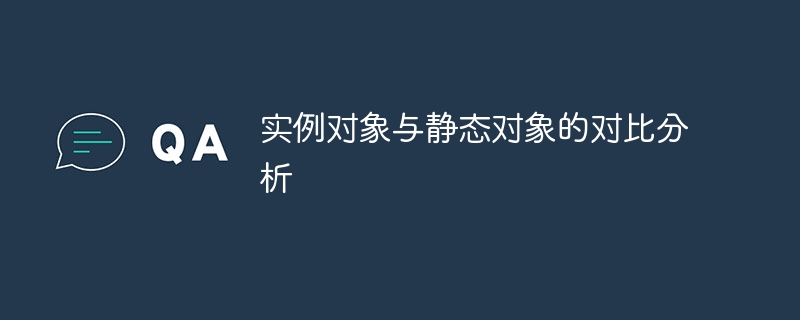Home >Backend Development >PHP Tutorial >Comparative analysis of instance objects and static objects
Comparative analysis of instance objects and static objects
- WBOYWBOYWBOYWBOYWBOYWBOYWBOYWBOYWBOYWBOYWBOYWBOYWBOriginal
- 2023-08-11 09:25:061344browse

Comparative analysis of instance objects and static objects
In object-oriented programming, objects are the basic unit of the program. Objects can be divided into instance objects and static objects according to their life cycles. This article will conduct a detailed comparative analysis on the characteristics, usage scenarios, and code examples of instance objects and static objects.
1. Instance object
Instance object is an object created according to class definition. Each instance object has its own data and methods. The characteristics of instance objects are as follows:
- Data independence: Each instance object has its own independent data space and will not affect each other.
- Life cycle: After the instance object is created, it can be created and destroyed at any stage of the program.
- Flexibility: Multiple instance objects can be created as needed, and each instance object can flexibly call and modify data and methods according to its own needs.
The following is a simple sample code that demonstrates the use of instance objects:
class Person:
def __init__(self, name):
self.name = name
def say_hello(self):
print("Hello, my name is", self.name)
# 创建实例对象
person1 = Person("Alice")
person2 = Person("Bob")
# 调用实例对象的方法
person1.say_hello() # 输出:Hello, my name is Alice
person2.say_hello() # 输出:Hello, my name is Bob
# 修改实例对象的属性
person1.name = "Charlie"
person1.say_hello() # 输出:Hello, my name is Charlie2. Static objects
Static objects are static members in the class definition , does not depend on any instance object. The characteristics of static objects are as follows:
- Data sharing: The data space of static objects is shared, and all instance objects use the same data.
- Life cycle: The life cycle of static objects is consistent with the life cycle of the program and exists throughout the running of the program.
- Applicability: Static objects are suitable for saving global data or shared methods that do not depend on instance objects.
The following is a simple sample code that demonstrates the use of static objects:
class Calculator:
# 静态对象,保存统计次数
count = 0
def add(self, a, b):
# 调用静态对象并增加统计次数
Calculator.count += 1
return a + b
# 创建实例对象
calculator1 = Calculator()
calculator2 = Calculator()
# 调用实例对象的方法
sum1 = calculator1.add(1, 2) # 返回:3
sum2 = calculator2.add(3, 4) # 返回:7
# 访问静态对象
print("Total counts:", Calculator.count) # 输出:Total counts: 23. Comparative analysis
Instance objects and static objects are used in usage scenarios and There are some differences in characteristics, so you need to choose the appropriate object type based on your specific needs.
- Data sharing and independence: The data of instance objects is independent and suitable for saving each object's own unique data; while the data sharing of static objects is suitable for saving global data or shared methods.
- Life cycle: The life cycle of instance objects is flexible and can be created and destroyed as needed; the life cycle of static objects is consistent with the life cycle of the program and always exists.
- Code reuse and flexibility: The code of an instance object is reused between different instance objects, but the data and methods of each instance object can be modified independently; static objects can be shared between each instance object. , but cannot be modified.
4. Summary
Instance objects and static objects play different roles in object-oriented programming. Instance objects are suitable for saving the unique data and methods of each object to achieve code reuse and flexibility; while static objects are suitable for saving global data and shared methods to achieve data sharing and global statistics. Based on specific needs, developers can choose the appropriate object type to meet the needs of the program.
The above is the detailed content of Comparative analysis of instance objects and static objects. For more information, please follow other related articles on the PHP Chinese website!

